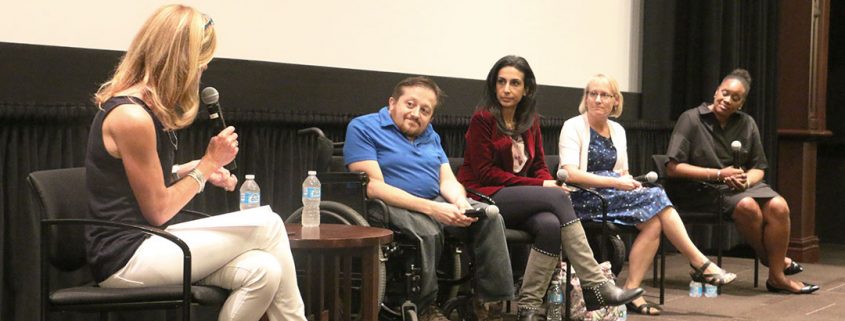Film screening panel highlights gender disparity in STEM
Almost 40 percent of the freshman class at USC’s Viterbi School of Engineering are women. The rest of the world, however, isn’t nearly as close to equality in tech industries. Panelists discussed this lack of equal representation after a screening of the documentary CODE: Debugging the Gender Gap at the Ray Stark Family Theatre on Wednesday.
The film traced the history of women in U.S. tech industries and the gradual decline of women graduates in mathematics in the 1980s. The panel featured Robin Hauser Reynolds, the director of the documentary, Viterbi professors Shirin Laor-Raz Salemnia, Trina Gregory and Rob Parke and Karen Wilkins-Mickey, senior manager of inclusion strategies at Expedia, Inc. The panelists talked about their personal experiences with sexism and gender disparity in the workspace.
“When the film first came out, I was so happy that someone was finally showing things that occur daily in the workspace,” Shirin Laor-Raz Salemnia said. “When I come out and say it, I’m just one person … But when you’re watching a movie about it, it becomes something much greater.”
Some students feel that though efforts have been made to encourage women to join computer science, the disparity between genders here on campus is still an issue.
“I just came from a class where there were probably four girls in a class of like 35 students,” said Nandhini Sivam, a sophomore majoring in computer science. “There’s definitely a gap and it’s closing. I know that it’s closing, because we have like three clubs on campus: Women in Computing, Girls in Tech and [Society for Women Engineers], so it’s definitely closing but not quite there yet.”
Other students feel that the lack of diversity in engineering is not just a social issue, but could potentially prevent coding from progressing.
“I’m a firm believer that if you have diversity of people in a field, you also have a diversity of approaches and ideas that can come out,” said Adam Espinoza, a sophomore majoring in computer science and business administration. “ [A greater] representation of women and POC can provide insights and possible solutions to common problems … because to minorities, the injustices are more profound, so minorities are more likely to fix things through the fields that they’re engaged in.”
CODE: Debugging the Gender Gap was created in order to explore the lack of diversity within coding and portray it as something engaging, creative and rewarding, according to the film’s website. This feature film hopes that by exposing audiences to girls who code, the fear of joining the male-dominated technology industry will dissipate.
“It’s not something that’s hard to do,” Sivam said. “It’s a matter of exposure and what’s portrayed in public media. There’s a lot more guys: male CEOs of these big companies, and you don’t really see women computing in the news; There’s never really a breakthrough that’s publicized as a woman figuring it out.”
Viterbi consists of 13.5 percent female faculty, 1.5 percent below the national average at engineering schools, said Amy Blumenthal, a spokesperson for Viterbi. However, the school is implementing programs locally and nationwide in order to even out the gender gap.
These efforts include the creation of the Institute of Engineering Community and Cultural Competence, also known as IEC3, which encourages girls from K-12 to cultivate an interest in code. Last year, Dean of Viterbi Yannis C. Yortsos spearheaded an effort targeted at the White House to encourage deans from engineering schools to commit to diversity. More than 170 deans have signed this pledge at this point. The school has also made an effort to get a TV show made about a female engineer background.
“We’re really changing the model,” Laor-Raz Salamenia said. “Here at USC, we’re very adamant about getting everyone into engineering…It shouldn’t be an issue of gender. We don’t live in a bubble of girls only, boys only.”

